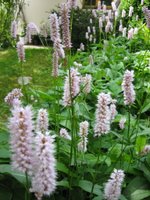An der Wildbahn 33
 I woke up to a blustery grey day and felt kind of light-headed and dizzy (from too much dancing and too little sleep) as I went to meet my boss, the curator of the artists' archives division at the Berlinische Galerie. We were driving that day to Heiligensee, a suburb right on the northenmost edge of Berlin city limits, to Hannah Höch's old abode at An der Wildbahn 33 for an afternoon with some members of the BG's foundation.
I woke up to a blustery grey day and felt kind of light-headed and dizzy (from too much dancing and too little sleep) as I went to meet my boss, the curator of the artists' archives division at the Berlinische Galerie. We were driving that day to Heiligensee, a suburb right on the northenmost edge of Berlin city limits, to Hannah Höch's old abode at An der Wildbahn 33 for an afternoon with some members of the BG's foundation.To most people she's known for being the lone female representative of the Berlin Dada-movement and for her daring lifestyle during Weimar/pre-Third Reich times (she was the mistress of Raoul Haussmann for time and after their lengthy but stormy relationship, her next serious partner was Dutch authoress Til Brugman). She was married for a short time to doctor and pianist Kurt Matthies, but she broke it off in 1944 because "I wanted children and he wanted a mother."
Her photomontages were some of the most polemically feminist and aesthetically innovative works ever created in the 20th century and it was a genre she mastered and whose singular style she even carried over to oils (like in The Bride, the painting below in the previous post). This one is called Roma:


Although hardcore Dadaists like Hans Arp reveled in the mechanization of mankind (a la the Italian Futurists), HH refused let go of that rural small-town girl part of her aesthetic vision. In 1939, after all her Dada compatriots had fled the country, she spent a good portion of her inheritance and her own income as a designer for the Ullstein publishing house on the estate in Heiligensee. She cultivated her garden according to her own tastes and whims, and as a result her small little garden feels like a nature-collage: cacti are plopped up right next to lilacs, a cherry tree grows over a patch of asters, next to a tropical flower called dim-dam which gives off a lemongrassy aroma. One can really feel lost and disoriented in this small little garden. We watched two videos in what used to be her atelier (now taken over as the studio of the artist who lives there now with his family). The first one was made in 1975, three years before her death. I was struck by how lively and gregarious she was, even as a white haired little lady of 83. She actually had a very girlish giggle after she would say something brash or amusing. HH was a student of Emil Orlik's in Berlin, a fact I somehow find so apt because in Prague I was particularly impressed by Orlik's work (I had never heard of him before) that I wrote his name down and my thoughts on him at the time. Anyway, HH really impressed me as a person, from what I could tell from the video.
The second one we watched was much more haunting. It was taken by her nephew exactly two weeks after her death in 1978. Nothing had been moved or disturbed in her house or garden--he recorded it on his amateurish Super 8 videorecorder and provided a languidly monotone voiceover commentary. The only moving things on screen were the flowers nodding in the breeze, the leaves rustling through the grass. No people, no animals; just the living plants that HH left behind. The commentary mostly consisted of free-association memories of his aunt and incredibly insightful quotes from and about the artist herself. Near the beginning of the film, as we see stuttering images from her garden, he says: "Hannah Höch war meine Tante. Es gibt kein Garten, der so wie meiner Onkel ist wie dieser." (Hannah Höch was my aunt. There is no garden that is so like my uncle like this one.) She never had any children and loved her nieces and nephews dearly, but she often talked about her flowers as if they were her children.
During WWII and the following Soviet takeover, Höch kept her art collection in a tiny attic hidden underneath a trapdoor. She was afraid the fascists would come and take away her and her friends' "degraded art", as they were so labeled once. It struck me sitting there in her old atelier that there must have been something about this house and her garden that compelled her to stay there through the worst of times. It was not just a source of inspiration to her, but it was her private paradise that sustained her sense of beauty in a destroyed world.



0 Comments:
Post a Comment
<< Home